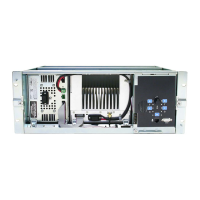144 Power Amplifier Fault Finding TB8100 Service Manual
© Tait Electronics Limited September 2006
8.7 Visual Inspection
The following procedures are intended as a guide for quickly finding basic
faults in the PA before proceeding to the more detailed checks. As some of
these checks apply only to particular models of PA, you only need to carry
out the checks which are appropriate for the model of PA under test. Unless
otherwise indicated, the circled numbers in the following instructions refer
to Figure 8.6 on page 146.
Task 1 —
Check for Physical
Damage, Missing or
Misplaced
Components
1. Remove the cover, as described in “Power Amplifier Disassembly
and Reassembly” on page 173.
2. Has the PA been dropped? Inspect the cover and heatsink for damage.
Check each board for loose or missing components. Replace any
defective board.
3. Has the PA been too hot? Check the boards and heatsink for
discoloration. Replace any defective board.
4. Check for loose bridging links
b, and missing or loose RF links c.
The quantity and location of these links will depend on the model of
PA.
5. Check that all screws are in place and secured correctly. Refer to
“Screw Torque Settings” on page 174.
6. Check that the ambient air temperature sensor board
d is fitted
properly and in the correct place. Replace the board if it is damaged.
Task 2 —
Check Quality of
Solder Joints
1. Check that the RF power transistor (MRF9060) e on the 60W
board(s) is soldered correctly. Refer to “Replacing the 60W RF
Power Transistor” on page 184.
2. Check the overall quality of the solder joints. Repair cracked or dry
joints as necessary.
Task 3 —
Check DC Supply
1. Check whether the reverse polarity protection diode f has failed
(short circuit). If it has, replace the 6W board.
2. Check the DC supply
g to the 6W board.
3. Check the DC supply
h to the 60W board(s).
Task 4 —
Check RF
Connectors
1. Check the SMA connector i solder joint. Also check the compo-
nents near this joint (e.g. C100 and L100).
2. Check the N-type connector solder joint
j. This requires the
removal of the shield lid. Refer to “Replacing the Low Pass Filter/
Directional Coupler Board” on page 188 for a description of
mounting and soldering the N-type connector.

